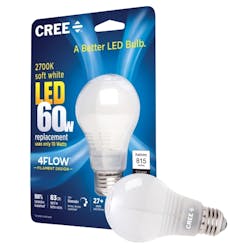Cree upgrades 4Flow LED lamp performance and life
New SC5 LED technology enables Cree to extend LED lamp life projection to 30,000 hours and raise CRI to 83 with the backing of a five-year warranty.
Cree has announced a new version of its 40W- and 60W-equivalent LED A-lamps that are based on the 4Flow Filament Design. The new products look identical to the existing 4Flow solid-state lighting (SSL) products that have been sold since last November, but higher-performance LEDs have enabled the company to improve color performance, raise the projected life, and increase the warranty. The price remains $7.97 with the lamps going on sell this month in Home Depot stores.
Interested in more articles & announcements on SSL design?
With the new design, Cree has extended the warranty from three to five years and projected life from 25,000 to 30,000 hours. CRI has gone from 80 to 83. The upgrades were enabled by the use of LEDs based on Cree's SC5 (silicon carbide 5) technology platform. Most of the LEDs announced by Cree in the past year are SC5-based products.
While an upgrade to a LED lamp design might not typically warrant a major publicity push by a company like Cree, the company has chosen to use the occasion of the A-lamp upgrade to push a message to the industry. Mike Watson, vice president of product strategy, said the SSL industry has entered a phase where lamp makers are chasing a low price point rather than pursuing good-quality light. "We're trying to make the industry grow the right way," said Watson. Recent trends toward lower prices could yet make LED lamps fail with consumers much like what happened with compact fluorescent lamps (CFLs), according to Watson.
Cree may be correct in general, but we see some valid technical and market reasons behind some of the low-cost LED lamps rolled out recently. For example, Philips Lighting recently announced a 60W-equivalent LED lamp that has been selling in two packs for around $5, but the lamp is only rated for 10,000 hours of life and has a limited feature set. But the company said specifically the lamps are designed for settings like hallways and closets that don’t require dimming or an omnidirectional beam. GE Lighting also released a low-cost lamp that it touts as a CFL replacement.
For now, Cree believes the full-feature approach is a better one for consumers. And Watson reminds us that with rebates enabled by Energy Star compliance, customers can buy the dimmable and omnidirectional Cree lamps for about the same price as the lowest-priced products on store shelves. Watson said rebates are available across the US in about half of the 2000 or so Home Depot locations.
The lamp announcement was also a bit surprising in that back in June, when Cree announced a major restructuring, CEO Chuck Swoboda had said Cree would move away from the lamp business with a more prominent focus on commercial lighting. Watson responded to questions about the focus by saying that the commercial sector accounts for about 80% of lighting revenue so that sector would obviously be increasingly important. But Watson also said the impact of the residential consumer is far bigger than the 20% slice of revenue since consumers often first encounter LED lamp technology at home and later make LED buying decisions at work.

Maury Wright | Editor in Chief
Maury Wright is an electronics engineer turned technology journalist, who has focused specifically on the LED & Lighting industry for the past decade. Wright first wrote for LEDs Magazine as a contractor in 2010, and took over as Editor-in-Chief in 2012. He has broad experience in technology areas ranging from microprocessors to digital media to wireless networks that he gained over 30 years in the trade press. Wright has experience running global editorial operations, such as during his tenure as worldwide editorial director of EDN Magazine, and has been instrumental in launching publication websites going back to the earliest days of the Internet. Wright has won numerous industry awards, including multiple ASBPE national awards for B2B journalism excellence, and has received finalist recognition for LEDs Magazine in the FOLIO Eddie Awards. He received a BS in electrical engineering from Auburn University.





